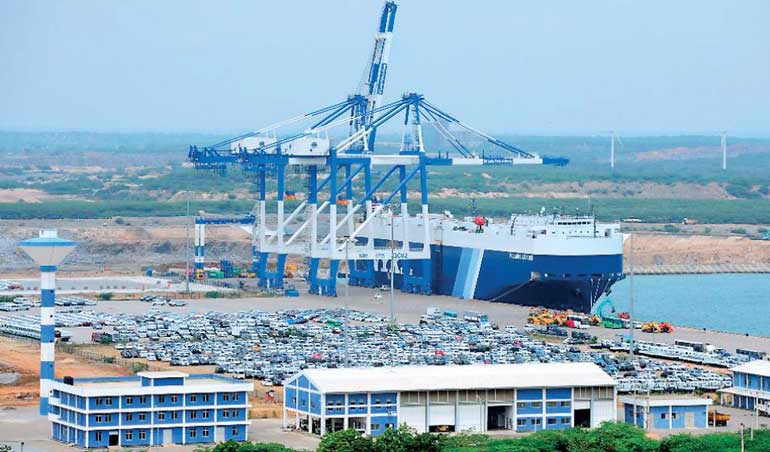Wednesday Dec 03, 2025
Wednesday Dec 03, 2025
Saturday, 6 August 2016 00:00 - - {{hitsCtrl.values.hits}}

By Wade Shepard
www.forbes.com: If there is a bright spot in Sri Lanka and China’s multi-billion dollar Hambantota debacle it’s that nobody has given up on it yet.
“Too big to fail” is a term that’s often been applied to China’s large-scale developments which don’t take off right away or appear to be failures that the Government continues pumping with new resources, funding, supporting infrastructure and ideas until they eventually come to fruition.
This development strategy is often regarded as foolish in the freer markets of the West, but in the context of the Chinese system — where the Government maintains a large degree of power over investment and the spatial positioning of enterprises — it can be made to work.
Shanghai’s Pudong financial center can no longer be considered a “statist monument for a dead pharaoh on the level of the pyramids;” Zhengdong New District is now the million person plus financial capital of Henan province rather than being “uninhabited for miles and miles and miles;” and even the “Great Ghost Mall of China” has come back from the dead. When we look across China we find that many of the booming new metropolises of today were the mocked and ridiculed ghost cities of yesterday.
Hambantota is a district in the south of Sri Lanka that over the past five years has been the site of one of the most ambitious development plans in the world. Featuring a $1.4 billion deep sea port, a large industrial zone, an LNG plant, an international airport, as well as a tourism zone, conference center, a world-class cricket stadium and some of the best highways in the country, Hambantota was supposed to have grown into Sri Lanka’s second most important city.
This plan was the work of Sri Lanka’s former president Mahinda Rajapaksa, for whom Hambantota was not coincidentally his hometown. To finance the projects here he looked towards China, who happily pumped the country with $8 billion in soft loans. This development worked to China’s interests as well, as Hambantota, Colombo South Port and the impending Colombo Port City were to be major parts of China’s Maritime Silk Road strategy, which aims to link together Chinese-invested and managed sea ports in Asia, Africa and Europe.
The biggest caveat to Sri Lanka’s ambitions in Hambantota is that it is in an extremely rural region that’s better known as the domain of migrating elephants. Literally, Sri Lanka and China aimed to build a new city in the middle of the jungle.
Almost needless to say, the Hambantota developments have so far struggled to break the inertia and come to life. With at most two scheduled flights per day, Hambantota’s Mattala International Airport is probably the world’s emptiest, the deep sea port is running at severe under-capacity, the conference center and cricket stadiums are seldom used, the smoothly paved new highways have very little traffic, and the industrial zone has yet to be built.
However, Sri Lanka hasn’t given up on Hambantota yet.
This morning, it was announced that China and Sri Lanka have formed a joint committee to devise and implement strategies to save the Hambantota project. This agreement came after Yi Xianliang, China’s ambassador to Sri Lanka, personally went out to Hambantota for an on-site inspection and then met with Prime Minister Ranil Wickremesinghe.
Chief on the agenda of this new committee is to develop the long awaited Sri Lanka-China Industrial Zone, which is vital for the success of the deep sea port, to facilitate discussions concerning land allocation, devise strategies to bring in Chinese companies, and to develop a Colombo-Kandy-Hambantota economic corridor, which will tie together many of Sri Lanka’s big development projects.
As of now, Hambantota is a prime example of an ambitious new city at a mid-point of development, which is perhaps the most tenuous stage. Building new infrastructure is always a long-term endeavor — a very expensive long-term endeavor which often does not produce adequate returns for many years, if not decades.
The conundrum is whether the developer has enough patience and cash flow to see their projects through to the end. If yes, that often means continuously dumping funds into projects that are not making any money (and potentially may not ever make any money); if no, that means a huge amount of already invested funds are going to be wasted and the landscape is going to be littered with half-built White Elephants that are of little use to anyone.
Sri Lanka has gone deep into debt trying to develop its infrastructure and economy with endeavors like the Hambantota project, and this has pushed the country to the brink of insolvency. Sri Lanka currently owes $58.3 billion to foreign financiers, which is taking up 95.4% of the Government’s total revenue to repay. The situation is not sustainable, and to these ends the IMF has jumped in with a bailout.
However, China has a history of sticking it out in large-scale development projects and rarely cuts its losses and runs, especially when so much leverage, geopolitical positioning and face is at stake. For China, it’s about the big picture — it’s about the broader Maritime Silk Road network — and Sri Lanka’s Hambantota dream is a core part of this.
No matter how bleak the prospects of this new city in the jungle may seem, Hambantota may very well be too big to fail.